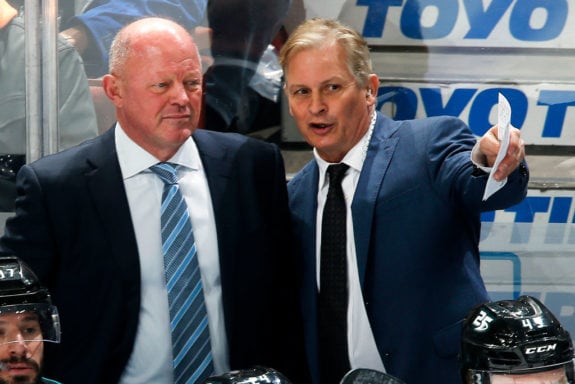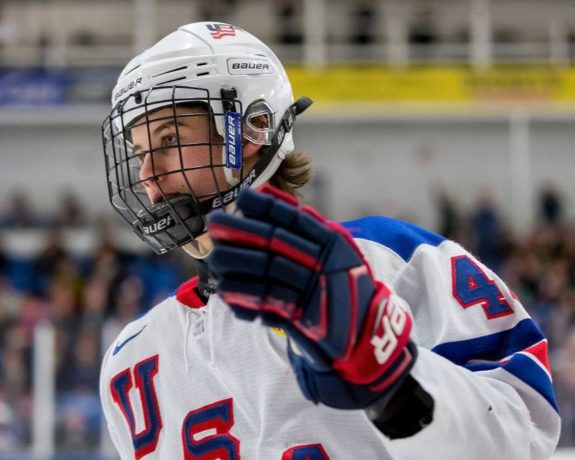General manager Bob Murray has been behind the bench for two games as the Anaheim Ducks’ new head coach. Following Kevin Boyle’s 35-save shutout in a 1-0 Anaheim victory over the Vancouver Canucks, the Ducks dropped a 3-0 decision to the Boston Bruins. There have been some bright spots for the Ducks in that time — Max Jones has played well, and Boyle’s success has been uplifting. But, the most interesting storyline is still Murray taking over as coach.

There’s a reason that coach/GM hybrids aren’t a common occurrence in the NHL — the two positions can have conflicting motivations and missions. When you consider the tightness at the bottom of the Western Conference and Murray’s dual role, the remainder of the season is going to be very interesting.
Western Conference Log Jam
The bottom of the league standings overall is tight which puts the Ducks in a volatile position. Anaheim is only six points out of the last place in the NHL and only one point out of second to last. But they are also seven points out of a wild-card spot (not that their recent play inspires hope).
Only five points differentiate the 22nd and 29th place in the standings. That makes a huge difference in draft lottery chances — it improves a team’s chances by 22.5 percent to secure a top three pick in the lottery. There’s also an eight percent difference between the 22nd and 29th pick when it comes to the chance of receiving the first overall pick.
With such a razor-thin margin to determine the chance of drafting a franchise player, Murray’s decisions will make a huge difference for the future of the franchise. But how will those decisions be impacted by his role as head coach?
Lose For Hughes?
Between Jack Hughes, Kaapo Kakko and Russian winger Vasili Podkolzin, the top-three prospects in the upcoming 2019 NHL Entry Draft are strong motivations for a struggling team to strive for the bottom of the league standings, rather than the top.

The Ducks are now one of those struggling teams, but it’s complicated for them now that Murray is their head coach as well as their manager. GMs and head coaches, especially on losing teams, can have totally different motivations and directives.
It’s the job of a GM of a losing team to understand their competitiveness and make the changes required to become a contender as soon as possible, even if that means selling talented players and losing more in the short term.
It’s a coach’s job to win — losing makes it harder to get a job in the future. After firing Carlyle, Murray told the Orange County Register’s Elliott Teaford and the assembled media:
“The whole purpose of this, and believe me this is not something I ever thought about or ever wanted because I have no aspirations to coach this game, but considering how things were and what I was seeing, what I was hearing, what I was feeling, I felt it was the only way,” (from ‘Ducks GM Bob Murray will coach and evaluate players’ – The Orange County Register – 2/12/19).
With “no aspirations” for a career as an NHL coach, Murray should have no problem evaluating young players and trading veterans even if it means losing more games. But players, like coaches, don’t want to lose. How will having a coach, who might have the short-term motivation to lose rather than win, settle with the players who also have to worry about being sent out of town?
In the Shadow of the GM
On top of Murray’s potential motivation to lose, there’s the uncomfortable reality for players that the man who can uproot their lives and send them to another team is literally looking over their shoulder now. It’s the main reason he took over, and he told the media as much. After he fired Carlyle he said:
“I felt I needed to be in the trenches. I talked to enough people where I know this is the right move for our organization right now. This is the only way for me to determine what the problems are.”
He also noted that stepping behind the bench would help him fix a perceived lack of leadership on the team. It can’t be comfortable for players to know that Murray now sees every reaction, every change in body language, every shift and interaction with teammates, and is evaluating how valuable each player is to the team in such an intimate way.
For Murray, he has to keep in mind that he still needs the trust of his players. For players on the roster and part of Murray’s future plans, he needs them to buy in and respect his vision for the team’s future. This will be difficult if it means sacrificing winning for future success.
Murray Will Have a New Perspective
Murray will now gain a new perspective on his players that he didn’t have before. How will he digest his players’ reactions to his coaching, their body language, and seeing their leadership from ice level?
In addition, coaches are around their players much more than GMs. They form attachments, they have favorites and they have scapegoats. Now that Murray is both, he runs the risk of having that influence his decision making. Maybe that’s not a bad thing, but these are all questions to keep in mind.

There are many conflicting motivations for Murray and remaining uncertainty for Ducks players. While Murray stepping behind the bench is probably the best option for the Ducks, Murray’s dual role as coach and GM will make things very interesting.